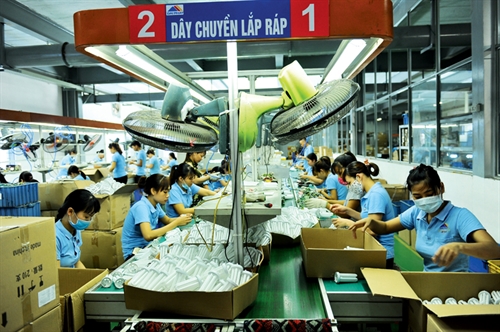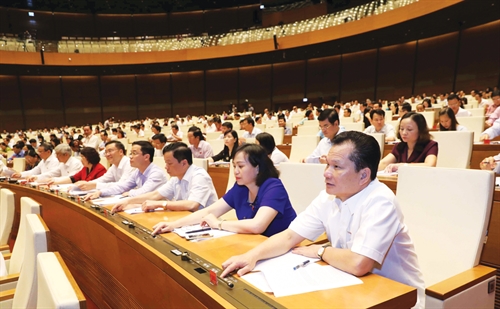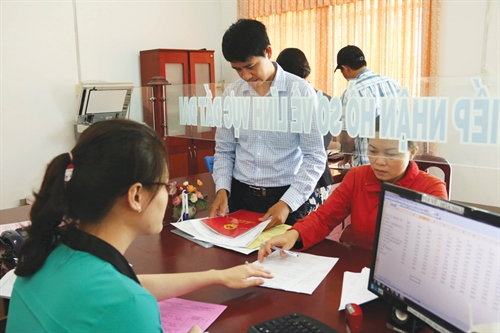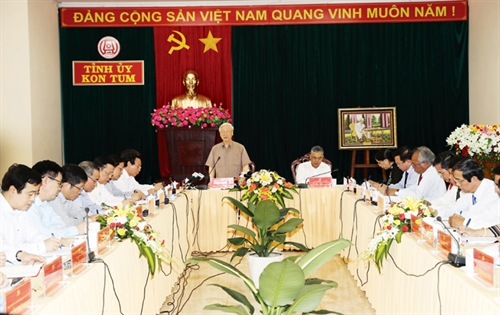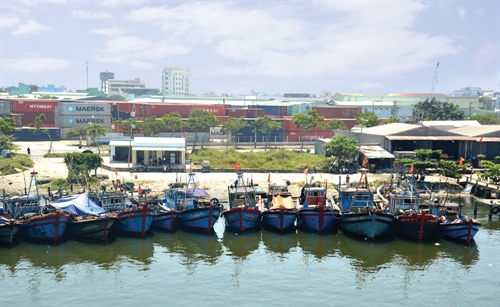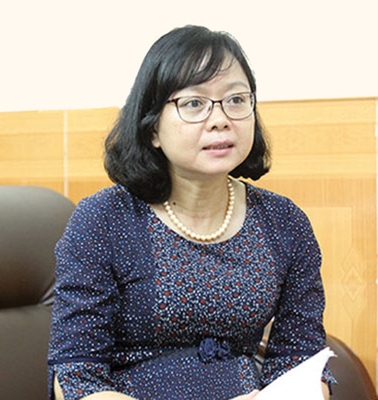 |
The National Assembly last month passed the Tourism Law at a high approval rate of nearly 90 percent. Replacing the 2005 Tourism Law from January 1 next year, the Law is expected to create a breakthrough in tourism development in the time to come.
Deputy Director of the Vietnam National Administration of Tourism Nguyen Thi Thanh Huong talks with To Quoc (Fatherland) newswire about new provisions of the Law.
Could you elaborate on the significance of the newly passed Tourism Law to the tourism sector?
As we all know, the current Tourism Law was issued ten years ago in 2005. Since then, the country has seen many economic, cultural and social changes. As a result, many of its provisions have become infeasible or unsuitable to realities and, therefore, need to be revised.
In the course of drafting the new tourism law, the Vietnam National Administration of Tourism (VNAT) strictly followed the Law on Promulgation of Legal Documents. We closely coordinated with related agencies and held many seminars to collect opinions from tourist experts and companies. We also published draft versions of the Law on the VNAT’s website for wider public comment. All of these moves were intended to ensure that the new Tourism Law would suit realities, facilitate the development of tourism and better ensure the interests of tourists. This is also the significance of the revision of the Tourism Law.
Fortunately, while the drafting was in progress, the Political Bureau adopted Resolution 08 on development of tourism into a spearhead industry. Hence, many guidelines set out in the Resolution were conveyed and included in the Law. Specifically, the Law affirms the State will adopt policies to mobilize all resources for tourism development in order to turn tourism into a spearhead industry of the country. Clause 2, Article 5 of the Law clearly states that tourism businesses are entitled to the highest investment incentives and support levels issued by the State.
What are the most notable provisions of the 2017 Tourism Law?
The most prominent change in the 2017 Tourism Law is the tourist-centered approach which can be regarded as the main spirit of the Law. Considering tourists as a vital part of the tourism industry without whom it cannot exist, the new Law touches on all issues related to the interests of tourists. For example, it clearly defines responsibilities of tourist site managers, travel companies, tour guides, tourist accommodation establishments and other tourist service providers, aiming to protect visitors’ interests in the best possible manner.
Another noteworthy change is the simplification of many administrative procedures. For instance, the 2005 Law requires businesses applying for international tour operator licenses to submit dossiers to provincial-level Tourism Departments or Culture, Sports and Tourism Departments for appraisal before forwarding to the VNAT for decision. Once the 2017 Law comes into force, businesses will file their applications directly with the Administration.
Under the 2017 Law, registration for ranking of tourist accommodation establishments will be made on a voluntary basis. First of all, these establishments must satisfy the conditions specified in Article 49. Then, those wishing to be ranked may register with competent agencies. The ranking of tourism accommodation establishments will be based on their service quality. Tourists will feel more assured when choosing ranked establishments. This is a major difference between the 2017 Law and the 2005 version.
In order to ensure the interests of tourists, the 2017 Law adds provisions on grant of domestic tour operator licenses. The 2005 Law only requires domestic travel agents to notify local tourism authorities of the time of commencement of their operation. However, after 10 years of implementation, this requirement has proved ineffective. Some domestic tour service providers still operate without establishing travel enterprises, meeting the business conditions or notifying their operations to competent authorities, leading to difficulties in protecting the interests of visitors.
The Law also defines more clearly responsibilities of local administrations and related ministries in ensuring social security, order and safety and ensuring tourists’ interests, thus facilitating the development of tourism.
How does the 2017 Tourism Law deal with unfair competition among tourist companies?
Article 9 of the 2017 Tourism Law provides a list of activities which are banned in tourism business. For example, it prohibits doing business without a license, using another’s license or letting others use one’s own license to do business. Squeezing illegal profits from tourists, fighting over for tourists or compelling tourists to buy goods or services are also illegal acts. These prohibitions will be specified in a legal document on sanctions against administrative violations in the tourism industry so as to sustain a sound business environment.
The 2017 Tourism Law has set more specific criteria for tour guides. Could you say something about this?
Compared to the current law, the 2017 Tourism Law contains several new provisions on tour guides.
First, it adjusts conditions for grant of tour guide’s cards. Under the current Law, international tour guides must possess a university degree, and local tour guides, a college degree. The 2017 Law now lowers the bar to college or intermediate degree for international and local tour guides, respectively. However, as tour guide is a job requiring not only professional degree and knowledge but also professional skills, easing this condition does not mean relaxing quality requirements on tour guides.
Second, the Law specifies conditions for practicing as tour guides, requiring them to sign employment contracts with travel or tour guide supply companies or be members of the tour guides’ professional association.
We are confident that these requirements will help improve the quality of tour guiding activities and attain the purpose of ensuring tourists’ interests.
The formation of the Tourism Development Support Fund is a matter of special concern to tourism businesses. How does the 2017 Tourism Law regulates this issue?
The formation of the Tourism Development Support Fund has been mentioned in the 2005 Tourism Law. However, over the past 10 years, it has not yet become a reality due to problems related to the fund’s revenue sources and operation mode.
Under the new Law, the Fund will take the form of an off-budget state fund founded under the Prime Minister’s decision. It will have a management board and an executive body.
Regarding its revenues, as stated in the bill presented to the National Assembly, the Fund’s charter capital would be allocated from the state budget while its revenues would come from voluntary contributions. However, we all know that the state funding is limited while voluntary contributions are not certain. Hence, in order to establish and effectively operate the Fund, it is necessary to seek annual funding sources for it. Luckily, as legislators all agreed on the necessity to establish the Fund, the National Assembly decided to add an annual revenue source for it from collected visa fees and sightseeing fees.
What have the VNAT and Ministry of Culture, Sports and Tourism planned for the implementation the Law?
The VNAT has completed and reported to the Ministry of Culture, Sports and Tourism a plan on implementation and dissemination of the 2017 Tourism Law. Together with widely disseminating the new Law among the public, the VNAT will actively prepare documents guiding its implementation and issue them before the Tourism Law comes into force on January 1 next year.- (VLLF)
| Vietnam welcomed more than 6.2 million foreign visitors in the first half of 2017, up 30.2 percent against last year, according to VNAT’s statistics. In June alone, around 950,000 foreign tourists visited the country, 33.6 percent higher than the same period last year. During the six-month period, arrivals by air reached 5.21 million, up 33 percent year on year; 170,800 visitors came by sea, up 26 percent; and the remaining 824,000 arrived by road, up 15.8 per cent. Northeast Asia remained the largest market for Vietnamese tourism in the first six months of 2017, accounting for 58.5 percent of total international arrivals. Southeast Asia accounted for 12.9 percent, Europe 15.8 percent, and America 7 percent. Among countries that recorded the highest growth in the number of tourists to Vietnam are mainland China (up 56.7 per cent), Russia (up 53.4 per cent), South Korea (44 percent), Cambodia (36 percent), Hong Kong (30 percent), Spain (28.6 percent), Philippines (24.3 percent), Taiwan (23 percent), New Zealand (19 percent), and Australia (10 percent). Meanwhile, the number of domestic holidaymakers reached 40.7 million in the first six months. Total earnings from tourism services hit close to VND 255. 7 trillion, representing an increase of 27.1 percent year on year.- |
